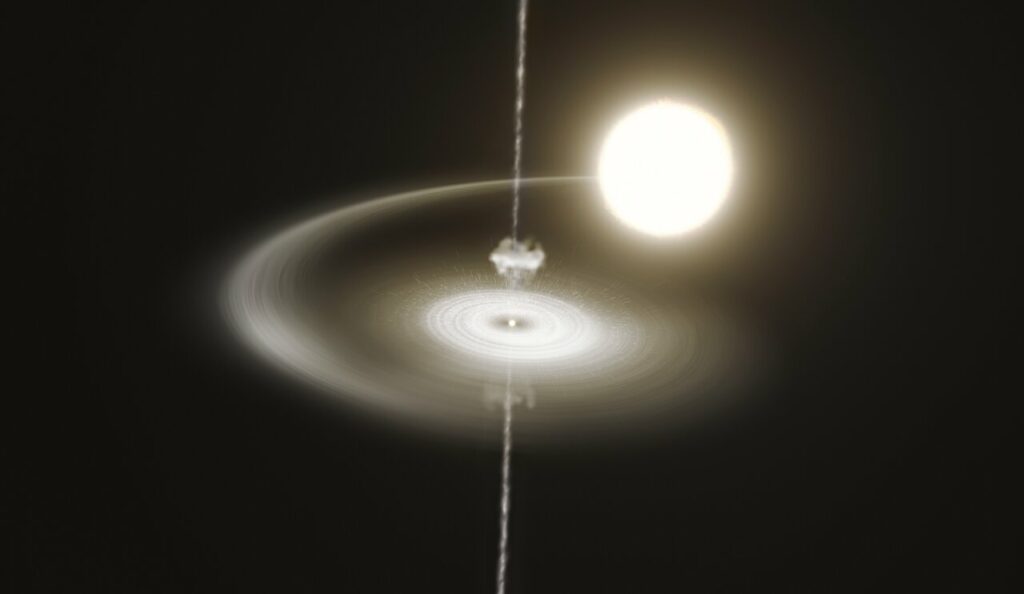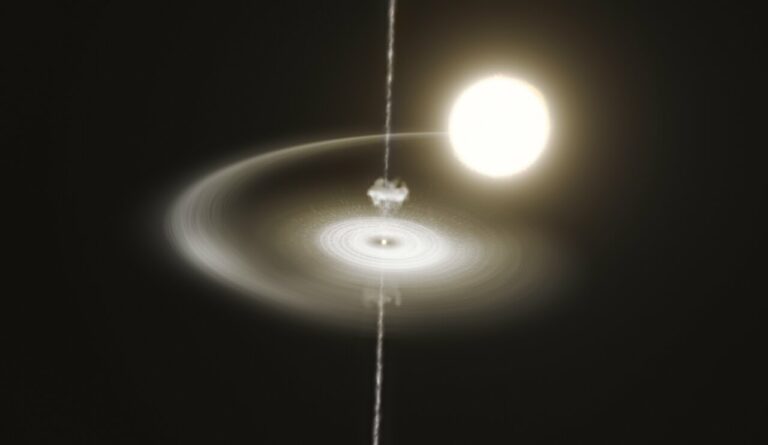Dead ‘vampire’ star is feeding on a companion and firing out cosmic cannonballs
“Enormous amounts of matter, similar to cosmic cannonballs, are launched into space within a very brief time span.”
Astronomers have deciphered the mysterious behavior of a dead star that’s greedily feasting on a stellar companion.

Credit: ESO/M. Kornmesser
Located around 4,500 light years away, this strangely behaving pulsar, or rapidly spinning neutron star, is designated PSR J1023+0038 or J1023 for short. And while blasting beams of radiation from its poles that periodically sweep over Earth, it seems to constantly switch between two distinct modes of brightness.
Astronomers couldn’t really explain such behavior at first, but now, a team of researchers might’ve solved the puzzle. They discovered that the pulsar’s brightness modes are the result of the object spitting out matter over very short periods of time.
“We have witnessed extraordinary cosmic events where enormous amounts of matter, similar to cosmic cannonballs, are launched into space within a very brief time span of tens of seconds from a small, dense celestial object rotating at incredibly high speeds,” Maria Cristina Baglio, leader of the research team and scientist at New York University, Abu Dhabi, said in a statement.
Extreme stars and puzzling pulsars
Like all neutron stars, pulsars are born when massive stars reach the ends of their lives, exhausting their fuel supplies used for intrinsic nuclear fusion processes. When such nuclear burning ceases in these stars’ cores, so does the outward energy flow that provides enough pressure to support the objects against the inward push of their own gravity.
As a result, the balancing act that has defined the star’s existence for billions of years ends — with gravity being the victor.
The star’s core then undergoes a gravitational collapse while its outer layers are blasted away in a supernova explosion. When this collapsing stellar core has a mass between that of the sun and around twice our star’s mass, and when its width shrinks down to around that of a city here on Earth, it births a neutron star.
The material that comprises this dead star is so utterly compressed by this collapse that it is considered the densest known matter in the universe. A mere sugar cube-sized chunk of neutron star matter, for instance, would weigh as much as 1 billion tons. That’s about 1,000 times the weight of the Golden Gate Bridge.
This rapid stellar collapse has other consequences, too.
Just like an ice skater draws their arms in to speed up while spinning during a routine, a rapid reduction in the radius of the stellar core means neutron stars have a vastly increased rotational speed — with some young neutron stars spinning as fast as 700 times per second.
That means when they are blasting out radiation from their poles as pulsars, these stellar corpses exhibit incredibly precise timing mechanisms.
Additionally, the collapse of stellar cores can push together stars’ magnetic field lines, causing them to vastly increase in strength and creating some of the most powerful magnetic fields in the known universe.
Even among its extreme stellar remnant classification, however, J1023 stands out.
Over the last 10 years, astronomers have witnessed the pulsar pulling material from its companion star. This stolen material forms a structure called an accretion disk around the pulsar itself, from where the clumps are gradually siphoned to its surface.
Since the feeding behavior of J1023 began, beams of radiation emitted from its poles have all but disappeared, and the pulsar has been switching from a “high-power” mode to a “low-power” mode. During the former mode, the pulsar shines brightly in X-rays, ultraviolet, and visible light, while in the latter, it appears dimmer and emits low-energy radio waves.
The pulsar stays in a specific mode for as little as a few seconds or as long as a couple of minutes — before switching again.
Cosmic cannonballs!
Baglio and colleagues observed J1023 with 12 space- and ground-based telescopes, including the Very Large Telescope (VLT) and the Atacama Large Millimeter/submillimeter Array (ALMA). Both are located in northern Chile, where they are part of the European Southern Observatory, and were harnessed by the scientists across two nights in June 2021.
This observing campaign allowed the team to watch the pulsar switch modes more than 280 times. The researchers ultimately found that this mode-switching arises from an interplay between the high-energy stream of particles blowing from the pulsar (called the pulsar wind) and matter falling toward it.
When it was in its low-power mode, the pulsar seemed to expel some matter flowing toward it in the form of a narrow jet orientated 90 degrees from the accretion disk.
As this was happening, matter wasn’t expelled in this jet accumulated close to the pulsar. This matter got slammed by the pulsar winds and began to heat up. That put the pulsar in its high-power mode, with the material glowing brightly in X-ray, ultraviolet and visible light.
Gradually, the jet from the pulsar whittled away this proximate hot and luminous matter, firing them out like cosmic cannonballs. This removes the hot material and causes the system to dim again, resulting in it switching back to its low-power phase.
Though this mystery may have been solved, astronomers aren’t done observing J1023 just yet.
In particular, the Extremely Large Telescope (ELT), currently under construction in the Atacama desert region of northern Chile could help astronomers study the switching mechanisms of J1023 in unprecedented detail.
“The ELT will allow us to gain key insights into how the abundance, distribution, dynamics and energetics of the inflowing matter around the pulsar are affected by the mode switching behavior,” Sergio Campana, research co-author and Research Director at the Italian National Institute for Astrophysics Brera Observatory, said in the statement.
The team’s results were published in the journal Astronomy & Astrophysics.
Source:SpaceCom
Do not forget to share your opinion with us to provide you with the best posts !




0 Comments